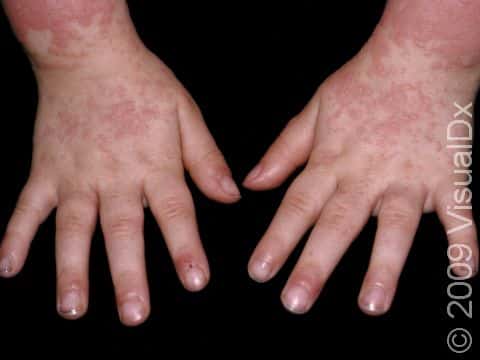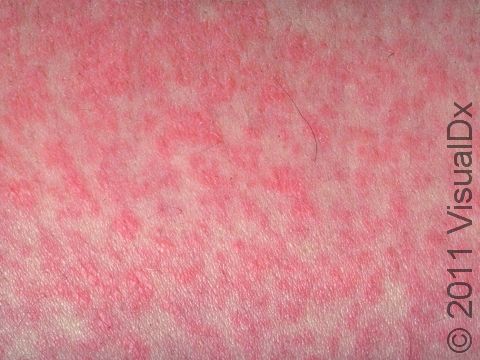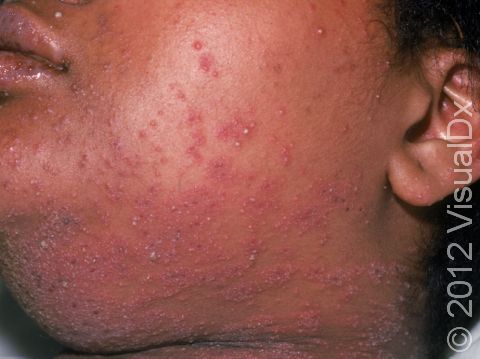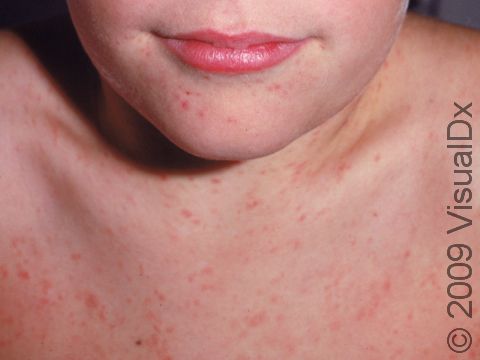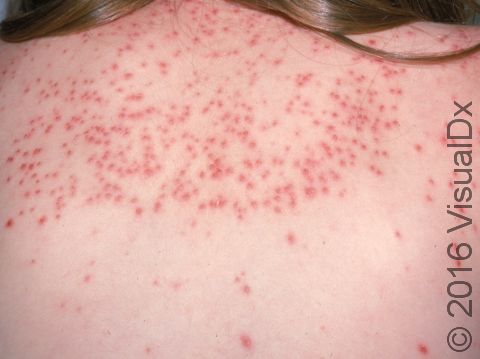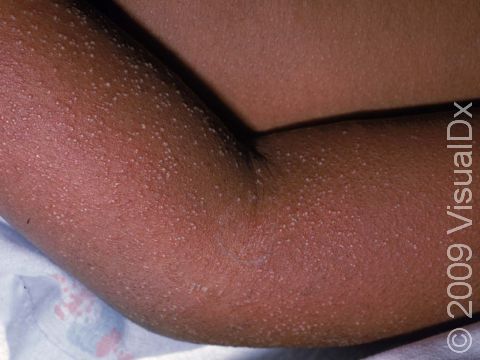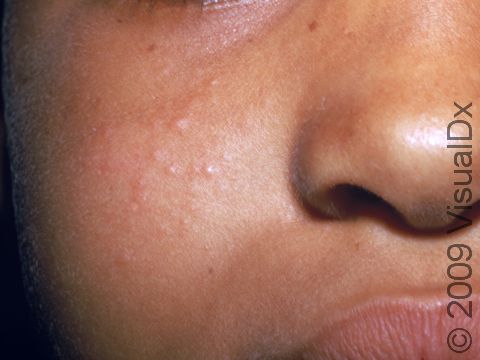Viral Exanthem
A viral exanthem is a rash caused by a viral infection. Many viruses can cause a similar-appearing rash, so it is difficult to tell which one is the culprit. Your child’s age, duration of illness, and other symptoms may suggest which virus is the cause. Airway (respiratory) and stomach (gastrointestinal) viruses are common causes of such a rash.
Who's At Risk?
Viral exanthem is common in children who have not yet developed immunity to common viral infections.
Signs & Symptoms
A widespread rash of pink-to-red macules (small, flat, smooth areas of skin), papules (small, solid bumps), patches (flat, smooth areas larger than a thumbnail), or plaques (raised or bumpy areas larger than a thumbnail) occurs primarily on the trunk, arms, and legs. In darker skin colors, the redness may be harder to see, or it may look purplish. Rarely, vesicles (small blisters) may be present. The rash may or may not be itchy. In addition to the rash, sometimes the child will not feel well and might have fever, fatigue, headache, loss of appetite, aches and pains, and irritability. Most viral exanthems last a few days or up to a few weeks.
In addition to the widespread rash on the skin, inside of the mouth, the genitals, and the eyes may be affected as well.
Self-Care Guidelines
For children with only mild symptoms, no treatment is required; the rash and illness often last for only a few days and go away on their own. However, to help improve the child’s symptoms, you might try:
- Giving children’s acetaminophen (eg, Tylenol) or ibuprofen (eg, Motrin, Advil) for low fever and aches and pains. DO NOT give aspirin.
- Applying over-the-counter 0.5% hydrocortisone cream or calamine lotion to help relieve itch.
- Making sure the child gets plenty of rest and liquids.
Treatments
Your child’s medical professional may do blood tests or cultures to look for more serious causes of their rash.
There is no treatment or cure for most viruses, so if the rash is viral in nature, the child’s medical professional may simply prescribe treatments to improve their symptoms, such as a topical steroid to help relieve itch, while waiting for the virus to clear on its own. If a serious bacterial or other infection is suspected, antibiotics may be given.
Visit Urgency
See your child’s medical professional if they have:
- Fever with a temperature over 101°F (38.33°C) that lasts more than a day.
- Severe headache, stiff neck, confusion, unconsciousness, or seizures.
- Diarrhea and/or vomiting and severe abdominal pain.
- Severe cough or phlegm containing pus or blood.
- Spots, swelling, and redness on the palms or soles; blisters; or swollen and painful joints.
- Red eyes, mouth, or tongue.
- Rash that is bright red and does not fade (blanch) when pressure is applied with a finger.
- A painful rash.
References
Bolognia J, Schaffer JV, Cerroni L. Dermatology. 4th ed. Philadelphia, PA: Elsevier; 2018.
James WD, Elston D, Treat JR, Rosenbach MA. Andrew’s Diseases of the Skin. 13th ed. Philadelphia, PA: Elsevier; 2019.
Kang S, Amagai M, Bruckner AL, et al. Fitzpatrick’s Dermatology. 9th ed. New York, NY: McGraw-Hill Education; 2019.
Paller A, Mancini A. Paller and Mancini: Hurwitz Clinical Pediatric Dermatology. 6th ed. St. Louis, MO: Elsevier; 2022.
Last modified on June 17th, 2024 at 1:34 pm

Not sure what to look for?
Try our new Rash and Skin Condition Finder

